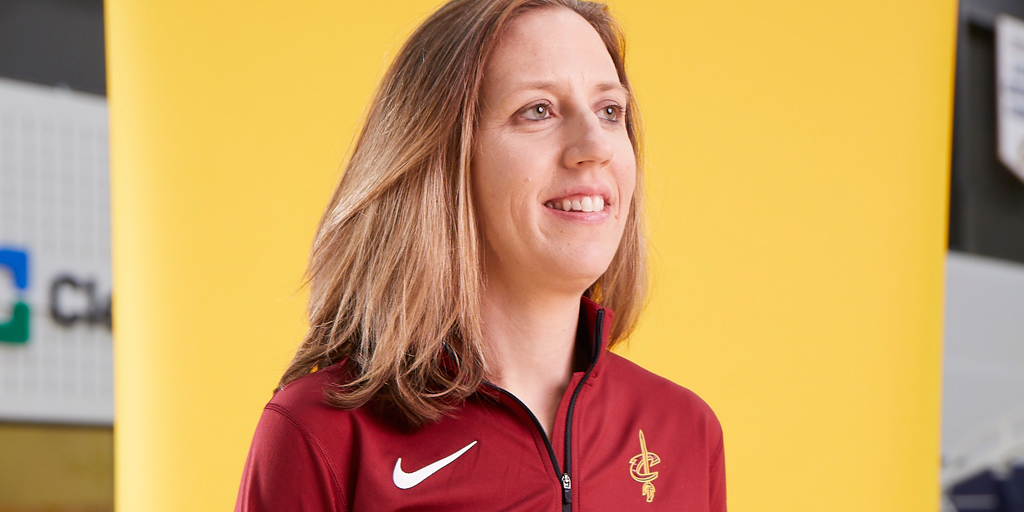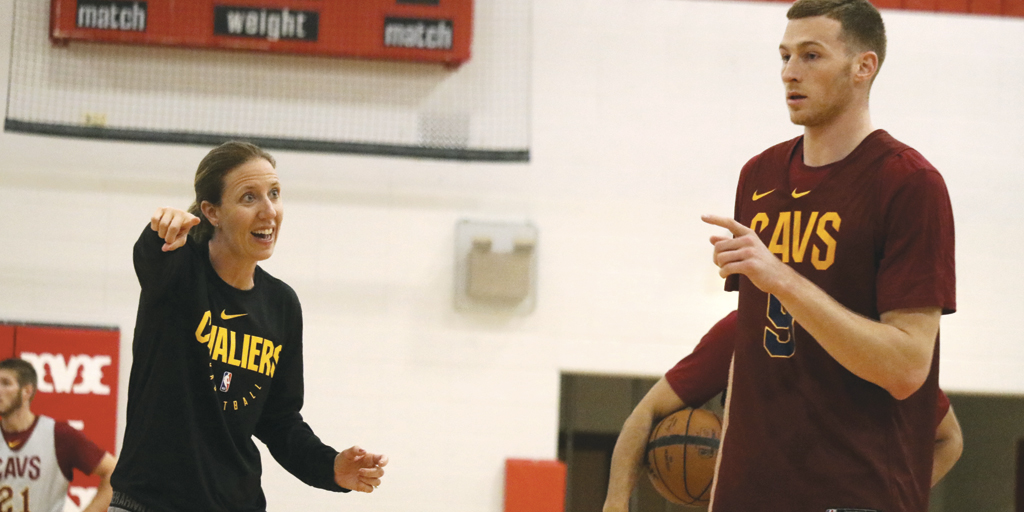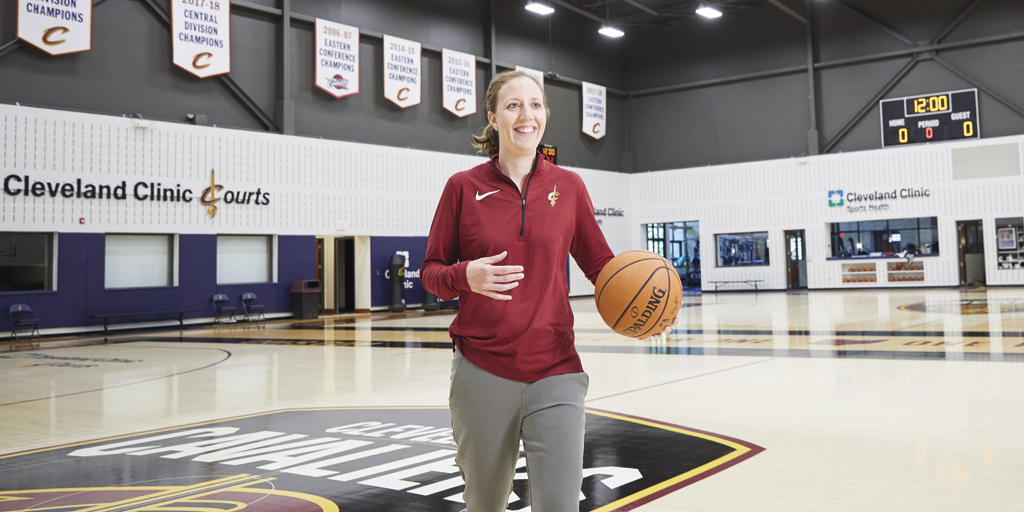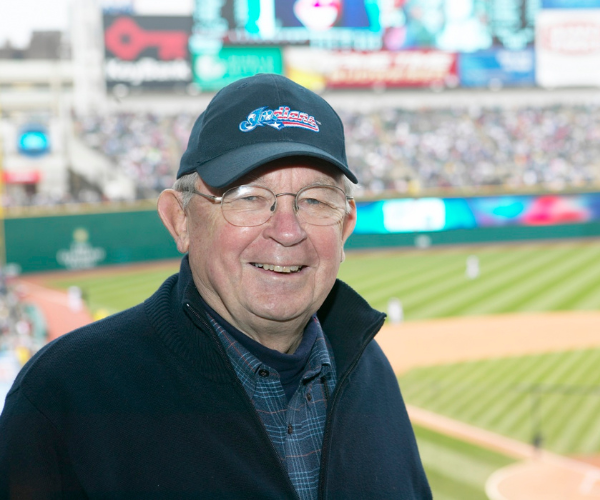Lindsay Gottlieb's Love Of The Game
by Rebecca Meiser | Sep. 30, 2019 | 12:00 PM

PHOTOGRAPHED BY KEVIN KOPANSKI
Lindsay Gottlieb’s mind was dribbling as she boarded the plane.
In May 2019, the California Golden Bears women’s basketball head coach had to prep for the junior NBA conference in Chicago. Her attention was also on her team, who’d lost in the second round of the NCAA Women’s Tournament in March. Three of their top scorers had graduated and critics were calling the 2019-2020 season a rebuilding year.
But she was still thinking about a text she received a few days before.
“Would you be able to do a call on Monday?” wrote Koby Altman, the Cleveland Cavaliers general manager. “I’m going to Chicago for a predraft camp. Once we get through that, I’d love to chat.”
Just days before, the Cavs hired University of Michigan’s John Beilein as their new head coach. Intrigued, Gottlieb agreed to meet with Altman that weekend over breakfast in a downtown Chicago hotel.
With the departure of LeBron James and Kyrie Irving, and all eyes on young, rising stars like point guard Collin Sexton, point guard Darius Garland, shooting guard Dylan Windler and shooting guard Kevin Porter Jr., it’s a new era for the Cavs — and they needed someone to help shape the team’s future.
During the meeting, Altman told Gottlieb that Cavs management was excited about what she could bring to an NBA team. Then he asked if she would be interested in joining the staff.
It was an offer that made Gottlieb’s head spin. She would be the first women’s collegiate head coach recruited to an NBA staff.
“I was completely blown away,” she says. “That’s not what I was expecting him to say at all.”
But Gottlieb had a good thing going with the California Golden Bears. She had a record of seven NCAA Tournament appearances during her eight years of coaching. She was beloved on campus, having taken the team to its only Final Four game in the school’s history in 2012-2013. And while it’s cliche to say that a team functions as a family, for Gottlieb, it was actually true.
The 41-year-old spent holidays with her team and sat with them at funerals. Before her husband Patrick proposed to her, he asked Kristine Anigwe, Cal’s all-time leading scorer and rebounder, for her blessing and permission. When Gottlieb found out she was pregnant, she told the team they’d be gaining a sibling. The close-knit relationship she had with her players was one of the reasons why she was so successful as a coach.
Indeed, one of the first things she thought when she got the offer was: What about McKenzie Forbes? And Mi’Cole Cayton? Or any of the 14 players?
Forbes was a 2018 McDonald’s All-American who’d connected with Gottlieb during her freshman year of high school and had specifically come to Cal to play for Gottlieb. And Cayton was an espnW HoopGurlz Top 100-ranked player in high school, who spent much of the past two seasons injured. Gottlieb made it clear to them and the other players on the team that she was invested in their growth.
What would her word mean if she left?
“There are so many things I love about coaching: the strategy, watching the film, finding ways to win,” says Gottlieb. “But if you strip all that away, I would still love the impact I know I can have on young women.”
She was also comfortable at Cal. According to a University of California compensation report, her gross pay in 2018 was $737,900. As the head coach, she had flexibility to run the program according to her own values. She went into every contract negotiation at the school thinking of time spent in the position over how much money was on the table. She’d imagined she would stay at Cal.
But she’d also imagined a different future, too, one in which she took on a leadership role in the NBA. She knew the game and the X’s and O’s as well as anyone. She’d been attending NBA camps and making connections. In her last contract negotiation with Cal, she’d even written in an out-clause if the NBA ever came calling.
She knew what an opportunity like this meant for the future of other girls and young women across the country, but she also knew everyone would be watching her closely, using her success or failure as a yardstick for future hiring decisions. Luckily, she’d spent her whole life turning others into believers.
“People can’t believe things are possible unless they physically see them,” she says.

Gottlieb always had her head in the game. She grew up in Scarsdale, New York, a tony suburb 25 miles northeast of New York City. As the youngest of four siblings, she was a string-bean-skinny tomboy, always playing sports with the neighborhood boys. Basketball, tennis, late-night lacrosse — if there was a ball involved, Gottlieb chased after it, and her parents were supportive.
Her father Stephen was a state Supreme Court justice and New York assemblyman, and her mother Carol was a stay-at-home mom-turned-stockbroker whom Gottlieb calls the “original badass female.” The two never batted an eye even when Gottlieb said she wanted to play for the New York Yankees.
In the fourth grade, while riding home on the bus, Gottlieb saw some of her male friends holding announcements for football tryouts. The headline read “Boys only.”
Gottlieb was indignant: Why shouldn’t girls be allowed to play a sport? She was just as coordinated as boys, just as good with her aim — if not better. Her parents agreed. They talked to the school and made sure Gottlieb was allowed on the team.
“My parents — my mother specifically — was so aware of not making me feel that there were things I couldn’t do,” Gottlieb says.
According to Gottlieb’s oldest sister, Chris Gottlieb, who teaches at the New York University School of Law, this was a conscious move on their parents’ part.
“I think girls often get the message that they should be insecure, and our society breeds that insecurity in young women,” she says.
Gottlieb’s parents saw sports as a tool for building confidence. She dodged tackles for three years as a quarterback for Scarsdale’s middle school league, but switched her attention to basketball in seventh grade. Although she was an excellent shooter, her greatest strength was her analytical ability to evaluate the game and other players around her.
After every club game, Gottlieb would visit her coach, who ran a shoe repair store in town, poring over the play-by-play of the previous matchup: who played well, who’d been a bit off, what needed to change for the next game. Her teammates trusted her instincts.
During one bout against a team that had future WNBA All-Star and Olympic gold medalist Chamique Holdsclaw as small forward, Gottlieb’s best friend waved off their coach’s calls because Gottlieb thought of different plans.
“Lindsay noticed that I was playing well, so she kept calling the plays,” says
Hilary Heieck, who would later go on to break Duke University’s all-time assist record.
Gottlieb may have stayed a better-than-average, overly cerebral player who eventually went on to law school, like two of her other siblings — if she hadn’t torn her ACL on the first game of her senior year of high school, sidelining her for the season. In an effort to cheer her up, her coach gave her an official Scarsdale High School polo shirt that had “assistant coach” embroidered on the front.
Gottlieb took the label seriously. Sitting on the sidelines, she had a whole different perspective on the game and she started drawing up her own schemes and plays.
In 1995, those lessons followed her to Brown University, where she had been recruited to play for the women’s basketball team. She ended up spending a lot of time on the bench, due in part to lingering ACL issues. Almost immediately, her teammates sought her out for coaching advice.
That helped forge a bond that Gottlieb needed those first two years at Brown. Her mother was diagnosed with cancer during Gottlieb’s freshman year and her condition continued to worsen through the summer before her sophomore year. Gottlieb wanted to stay with her and help out at home, but Carol wouldn’t allow it. No way would her daughter be sidetracked because of her.
But a week after Gottlieb’s sophomore year started, her mother died. Her father had to deliver the news by calling the landline in her dorm room and having her roommate relay what happened.
“Within five minutes, our entire team was in our dorm room,” says Gottlieb. “There were no cellphones, so people were probably knocking on each other’s doors in the dorm room, saying, ‘Hey, we’ve got to get to Lindsay’s.’ ”
That sense that your teammates are your bedrock formed the core of her earliest beliefs as a coach.
“You hold each other accountable and you’re there for one another and you help each other succeed,” says Gottlieb. “You go through a very sort of true and unsugar-coated experience together.”
In 1997, Gottlieb took a year off from playing basketball to study abroad in Australia. While on a side trip to a small village, somewhere between Thailand and Burma, Gottlieb came across a troupe of children who were practicing a dance they planned to perform later that night to visitors.
In front of them, an elder man was leading them through the movements, and even from a distance, Gottlieb could tell how firm and kind he was. She could see how the children looked up to him, and how much he and this dance meant to the kids and their lives. As she watched them, she had an epiphany — she wanted to have that kind of impact.
“I love the X’s and O’s, but I also love the human element of it,” she says.
When she returned to finish her senior year, she sent introductory letters to all 347 Division I women’s college basketball teams. At first, she snagged a few interviews but nothing landed. After her 1999 graduation, as she was heading home, an offer came through for an assistant coach position at Syracuse University. She accepted on the spot.
“I felt like I was on my way,” she says.

When former WNBA star Becky Hammon was hired as an assistant coach for the San Antonio Spurs in 2014, the story was front-page news across the country. She was the first female who had been hired in a full-time assistant position in any of the four major professional sports in the United States.
By the time Altman approached Gottlieb, seven other women held either assistant coaching or player-development roles on an NBA team. In May, NBA basketball commissioner Adam Silver declared that he wanted to see even more women in the league. His personal goal, he announced, was for women to make up half of all new referees joining the NBA, and he encouraged teams to consider hiring more women as coaches as well.
“[There is] a small but growing trend of looking at talent across the basketball world, regardless of gender, and seeing how that would apply to the professional level with the men,” says ESPN.com writer Mechelle Voepel. “They are diversifying their talent pool.”
Hiring Gottlieb is noteworthy as she is the only female head coach to come from women’s college basketball straight into the NBA.
When Gottlieb took over as head coach for the California Golden Bears in 2011, they were coming off a subpar season and finished 18-16 overall. The team carried a mixed bag of experience levels comprised of bright, up-and-coming players and skilled upperclassmen of the sport.
“We underperformed the year before,” recalls Layshia Clarendon, Gottlieb’s former guard who now plays for the WNBA’s Connecticut Suns, “but we were pretty hungry.”
Gottlieb believed her team had a lot of talent, they just needed to work in a system that better fit their strengths. So she adapted to the teams’ personalities and abilities.
They weren’t very tall, but they were quick and strong. To accentuate that speed,
Gottlieb changed up their conditioning. Instead of doing longer runs, she had the team doing circuit-style sprints. Instead of resting the day before games, she had them running because she wanted them on their feet. And because their shooting percentages weren’t stellar, Gottlieb had the team aiming instead to be the best at offensive rebounding.
“So many coaches are so rigid,” says Talia Caldwell, who played center at Cal. “They try to make square pieces fit into round pegs. That wasn’t Lindsay. Coach G was like, ‘Let’s make you the best square peg team that exists.’ ”
Gottlieb encouraged everyone to bring their whole selves to practices and games. She was confident enough in the team’s internal dynamic that she didn’t care how her girls presented themselves externally — be it through mohawks, dyed hair or self-made music videos they posted on the internet.
In 2011, they went head-to-head with teams like Ohio State University and Rutgers University, losing by less than three points. They pulled off a 59-50 upset against the University of Virginia Cavaliers, finished the season 25-10, and attended the NCAA Tournament for the first time in three years.
Gottlieb had hit on something magical and it extended into the next year. Ranked 13th in preseason polls, the team ended up with a 32-4 record in the 2012-2013 season, and made it to the Final Four for the first time in the school’s history.
“When you see people have success where people haven’t usually had success, it’s usually a very good indicator of their quality,” says Beilein.
He made it known during his meeting with Gottlieb in May that he didn’t want to be surrounded by “yes men.” Beilein wanted people coming in from different angles with different perspectives.
“There’s an old saying: ‘You are what your record says you are,’ ” he says. “And when you come from a school like Cal — which is never a school you think about for women’s basketball — and you go to the NCAA Tournament seven out of eight years, you are a heck of a coach.”
Beilein had always admired the women’s side of the sport, taking in as many games as he could at Michigan. He was in awe of what he says was a noticeable difference from the male sport.
“In the women’s game, there’s not as much of ‘I’m going to jump over you and score.’ There are more schemes,” he says. “As a result, you have a great understanding of both offensive and defensive plays. You don’t just win through athleticism.”
The fear of not being accepted by others motivates Gottlieb.
When she became an assistant coach for the first time at Syracuse, Gottlieb, who was 21 at the time, was also pursuing a master’s in philosophy of education and taking classes alongside one of her team’s best players. The experience made her wonder how she could ever assert herself as an authority figure to players who were ostensibly her equals.
“I told the team that I was them the year before,” says Gottlieb. “I was the one in practice, not the one coaching.”
Two years later Gottlieb became assistant coach at the University of New Hampshire, and by the time she was 24, she was working as an assistant to Joanne Boyle, the women’s head coach for the University of Richmond. That move, says Gottlieb, was instrumental in becoming the kind of coach she is today.
“She didn’t say, ‘OK you’re going to be my assistant.’ She said, ‘Let’s do this thing together,’ ” recalls Gottlieb. “She really empowered me to be ready to be a head coach.”
In three seasons, the duo amassed a 67-29 record, with three straight post-season appearances. In the duo’s last year together at Richmond, the team advanced to the NCAA championships — its first ever appearance.
When Boyle was recruited as a head coach for the University of California in 2005,
Gottlieb was part of the deal, but she once again had a moment of fear.
“The job meant flying 3,000 miles away,” she says. “I played Division I ball but not at that caliber, so I didn’t know if they’d respect me.”
Boyle, though, told Gottlieb they’d face the job together. For three years, they worked as a team, and when the opportunity came up for Gottlieb to become the head coach at UC Santa Barbara, Boyle encouraged her to take that. But three years in, Boyle left Cal for the Virginia Cavaliers and Gottlieb returned to Cal to become head coach. A few months later, the two faced off in a 59-50 Cal upset.
“Neither of us wanted to play one another,” says Gottlieb. “But what [Joanne] and I have proven over the years is that the relationship is always more important than the professional moment.”
And there are things more important than fear. While at Duke in 2001, after completing a run, Boyle felt a stabbing pain in her head. It turned out she had had a brain aneurism — and miraculously survived. So as Gottlieb hemmed and hawed over each and every decision in her life, she was reminded of what Boyle once said: When you suffer something so life-threatening — as all of us may — what is there really to be afraid of?
“As I was thinking about this Cavs offer and remembering that time, I realized, This is exactly why you have to take it,” she says.

It’s a Friday afternoon in August and Gottlieb has just finished practice with the Cavs. Her arms are sore. She had almost forgotten what it’s like to be an assistant coach, that it requires you to be out on the floor more, interacting and practicing with the players. Wearing a long-sleeved gray Cavs Nike shirt, light blue leggings and pale pink nail polish, she smiles warmly.
It’s been a whirlwind of change over the last few months. She’s had to leave behind the Oakland house she lived in for eight years — the only home her two-year-old son, Jordan, has ever known. Her husband had never even lived outside of California, but they’re here now, one day after signing papers for their new house, making a new life for themselves. Gottlieb already has an iPhone album full of photos of Jordan joyfully splashing water at the Children’s Museum of Cleveland, which she happily shares. Despite all of the sudden change that’s happened, Gottlieb is incredibly excited for the new season and her new colleagues.
In many ways, this latest version of the Cavs is similar to the Golden Bears team Gottlieb inherited in 2011. Last year, the Cavs finished second-to-last in the Eastern Conference with a 19-63 record — a far cry from their four straight NBA Finals appearances, one of which resulted in a championship win.
Already, Gottlieb has begun developing Cavs rookies Windler, Garland and Porter Jr.
“We’re doing a lot of shooting right now, helping them understand the offense we’re going to be putting in,” Gottlieb says. She’s also spent time with them over breakfasts and lunches, just trying to be part of their day. She’ll be wearing many different hats as the season progresses.
“I’ll be assisting the whole program, with maybe a little more focus on the offensive end,” she explains. That involves working on strategic planning and helping the offense run smoothly, whether through matchups and lineups or breakdown drills.
She admits one of her biggest worries when taking the job was how the players might relate to her, but she’s felt that before.
“I don’t know what they’re saying when they go home, but it’s crazy — in the building, in our practice facility, I’ve just been completely treated like a coach,” she says.
Beilein has been impressed with the connections she’s already forged with players, and the insights she’d gained by spending time with the rookies during summer league.
“She’s brought up some really good points of things, that I did not see, that we can use both on and off the court,” he says. “She’s already given me good advice for how to build a relationship with them.”
As she settles into this new life, Gottlieb thinks often about one of the last questions her husband asked as she stood wavering — one last time — before signing her four-year contract with the Cavs in May.
“What do you want your legacy to be?” he asked.
And Gottlieb realized that she already knew the answer.
For more updates about Cleveland, sign up for our Cleveland Magazine Daily newsletter, delivered to your inbox six times a week.
Cleveland Magazine is also available in print, publishing 12 times a year with immersive features, helpful guides and beautiful photography and design.
Trending
-
1
-
2
-
3
-
4
-
5










